1. Khop — Into the Wild
Phou Pha Daeng (Red Cliff), Khop District’s highest peak and the 2,200-ha Phou Pha Daeng Mountain Conservation Area’s centerpiece, rises 1,488 meters above the 10-km-long ridge in the heart of the district. Along with two fascinating caves, the conservation area is home to deer, tigers, bears, monkeys, and a variety of birds.
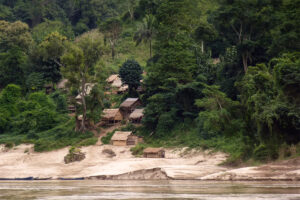
2. Xienghone — Land of Peace
An adventurous three-hour ride from Ngeun will bring you to Xienghone District. Famous for its ancient Xienglom Stupa dating to 1305, Xienghone is a charming quiet place. For traditional lifestyle and weaving explore Ban Khing and Ban Kham. Close to Ban Kham a perfect place for meditation is Vat Otoumkham – located in the middle of the forest. Don´t miss visiting the cave of the giant bats! For information on tours and transport services please contact the Tourism Office.

3. Phiang — Farming the Land
Phiang, a major rice farming area of Laos, has several natural and cultural wonders to offer to the adventurous traveler. The Tham Aram (Monastery Cave), hot springs near Pakklak, and the Tham Phawai (Rattan Cave) near Ban Somsavath where you will see many Buddha images. The Rice Festival in Phiang is also a must-see in this little-known but very rich region of Sayaboury. Phiang is also one of the entry points into the wonderful Nam Pouy National Park.

4. Thongmixay — Protecting Elephants
Laos’ only National Protected Area (NPA) west of the Mekong, the Nam Pouy occupies 1.912 Km2 along the Thai border. Steep and rugged ridges mostly of Mesozoic sandstone and shale characterize the NPA’s terrain, with peaks reaching 1.790 meters. Nam Pouy has the world’s easternmost native teak forests and seasonal evergreens along rivers. 50 mammal species including an estimated 80 wild elephants inhabit the forest along with gaur, tigers, dholes, serows, and Asiatic black bears.
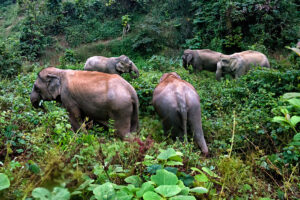
5. Boten — Graced by Nature
Boten’s easy-to-reach, lore-filled Tad Ham Waterfall on Phoudaeng (Red Mountain) near the municipal center makes for a very interesting journey in the southernmost district of Sayaboury Province. Visitors can trace the way to the falls along a 3 km road from the Boten District center. A trail from the road leads to the peak of Phou PhaDaeng (Red Mountain), one of the area’s highest, and a great view of the red limestone formations all the way to Thailand.
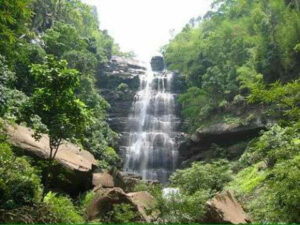
6. Hongsa — History and Weaving
Weaving. The Lue village Ban Viengkeo is most famous for its elaborate weaving traditions. Dye yarn from homemade natural colors and learn how to weave. Ban Viengkeo is located very close to Hongsa town, and just a one hour ride away from the Mekong boat landing Tha Suang, and two hours by car from Sayaboury.

7. Saysatthan — People from the Hills
Prying into the Phrai. Sayaboury’s Saysatthan District is one of only two Lao provinces the country’s 15,000 or so Phrai call home, and their distinct culture, language, and lifestyle vary widely from most other minority groups. They inhabit the mountains in Saysatthan. They have no written language, and since metal is taboo, they have mastered bamboo to create almost all of their household needs.

8. Sayaboury — Elephant Heritage Trail
The Province’s Capital. The city hosts the famous Elephant Festival every year in mid-February. The festival commemorates the nation’s living icon. The two-day celebration, filled with elephant-related activities and performances, kicks off with an elephant procession and monks’ blessing. The town is surrounded by the gorgeous Elephant Mountain Range.
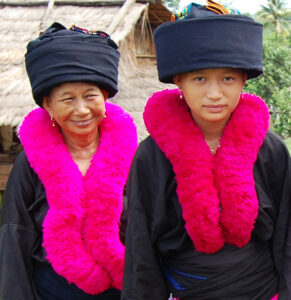
9. Paklay – Crossing the Mekong
Known for its cave clusters, hot springs, and sacred Vat Sisavangvong temple (one of Laos’ three highest regarded temples), and steeped in history, culture, and nature, Paklay acts as a gateway to the province’s south and Sayaboury District. Exploring the district center’s side streets reveals several old wooden buildings and temples. Besides the Phavet and Rocket Festivals, the district hosts longboat races with 50-to-70-person squads.
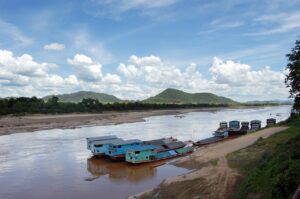
10. Kenthao – The Southern Gate
Mountains, waterfalls, temples, and legends hold the secrets of Kenthao’s past. The district borders Thailand and has an international border checkpoint at the Nam Heuang Thai Friendship Bridge, which welcomes Thais visiting from Loei Province. Vat Siphoume, the district’s most sacred site is a 15th-century temple that reveals stupas for Phengsi and Thodam, two legendary characters. A visit to Tad Ham Waterfall, dropping 15 meters over massive rocks into a large, clear pool is a must-see.

11. Ngeun – Land of Cotton
Crossing the international border checkpoint from Thailand in Ngeun or coming from Pakbeng (Oudomxay), book a tour at the Tourism Office and witness the mystic secrets of the spiritual ritual of natural indigo dyeing. Visit the “Sayaboury Cotton Farmers” – and observe all steps of traditional Lao cotton processing, from plant to fabric. At Ban Nangoua witness hand-made pottery production. A walk through rice paddies will reveal a natural highlight, the Earth pillars (Saodin). And don’t miss the opportunity to listen to the mystic story of the silver elephant at Vat Si Boun Yeun Temple.

THE FOUR NORTHERN DISTRICTS
Sayboury Province’s four northern districts – Hongsa, Ngeun, Xienghone, and Khop – will take you off the beaten path right into the land of ancient spiritual beliefs and handicraft traditions. En route to Luang Prabang and Vientiane, or on your way to and from Northern Thailand, Sayaboury – the “Land of the Elephants” – is a perfect stop in between – just stay another day!
Festivals: Enjoy vibrant festivals such as the Boat Racing Festival, the Spiritual Ghost Festival, Pi Mai Lao (New Year), or Khmu New Year. And every February the must-go for all friends of pachyderms is the national Elephant Festival – don´t miss it!
Mystic: All year round you can learn about ethnic minority groups like the Lue, Yuan, Iu Mien, Phrai, Hmong and Thai Dam; each with unique beliefs in spirits of nature and Buddhist rituals that reveal ancient traditions. Immerse yourself in traditional lifestyles and enjoy the welcoming hospitality of the Lao people.
Adventure: Ready for Sayaboury’s adventures? You will get your money’s worth on Sayaboury’s off-the-beaten-path tours by boat, motorbike, and trekking. Visit the Elephant Conservation Center at the Nam Tien Protected Area and get to meet elephants in their natural habitat in one of Asia’s best-managed sanctuaries!
Relax: For a tamer adventure head to the Nam Tien Natural Protected Area near Sayaboury city, play golf, or enjoy the view over the lakeside with Lao cuisine. For meditation and a traditional spa, the best spot in town is the Herbal Spa Center at the Nam Heuang River banks.
The four districts are bordering the Mekong River in the North and Thailand in the South. A national road crosses the districts and connects all of them with the provincial capital of Sayaboury. All four districts have access to the Mekong where boat services are available to Bokeo, Oudomxay, and Luang Prabang.
Since December 2008 there is an international border checkpoint in Ngeun District, connecting Thailand, Laos, and China/Vietnam by a new international road linking Nan Province (Thailand), Ngeun District, and Oudomxay province.
Also, the land route from Chiang Mai to Luang Prabang makes traveling shorter, offering beautiful nature on both the Thai and Lao sides.
The steady improvement of the infrastructure for tourism – all districts offer guesthouses, restaurants and public transport – provides new attractive tourism destinations in still remote rural areas. Come and see!



 ລາວ
ລາວ
